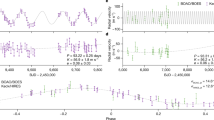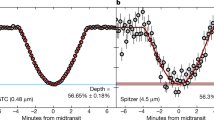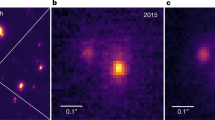Abstract
Planets that orbit their parent star at less than about one astronomical unit (1 au is the Earth–Sun distance) are expected to be engulfed when the star becomes a red giant1. Previous observations have revealed the existence of post-red-giant host stars with giant planets2,3,4 orbiting as close as 0.116 au or with brown dwarf companions5,6 in tight orbits, showing that these bodies can survive engulfment. What has remained unclear is whether planets can be dragged deeper into the red-giant envelope without being disrupted and whether the evolution of the parent star itself could be affected7,8,9. Here we report the presence of two nearly Earth-sized bodies orbiting the post-red-giant, hot B subdwarf star KIC 05807616 at distances of 0.0060 and 0.0076 au, with orbital periods of 5.7625 and 8.2293 hours, respectively. These bodies probably survived deep immersion in the former red-giant envelope. They may be the dense cores of evaporated giant planets that were transported closer to the star during the engulfment and triggered the mass loss necessary for the formation of the hot B subdwarf, which might also explain how some stars of this type did not form in binary systems.
This is a preview of subscription content, access via your institution
Access options
Subscribe to this journal
Receive 51 print issues and online access
$199.00 per year
only $3.90 per issue
Buy this article
- Purchase on Springer Link
- Instant access to full article PDF
Prices may be subject to local taxes which are calculated during checkout


Similar content being viewed by others
References
Udry, S. & Santos, N. C. Statistical properties of exoplanets. Annu. Rev. Astron. Astrophys. 45, 397–439 (2007)
Setiawan, J. et al. A giant planet around a metal-poor star of extragalactic origin. Science 330, 1642–1644 (2010)
Silvotti, R. et al. A giant planet orbiting the ‘extreme horizontal branch’ star V391 Pegasi. Nature 449, 189–191 (2007)
Lee, J. W. et al. The sdB+M eclipsing system HW Virginis and its circumbinary planets. Astron. J. 137, 3181–3190 (2009)
Maxted, P. F. L., Napiwotzki, R., Dobbie, P. D. & Burleigh, M. R. Survival of a brown dwarf after engulfment by a red giant star. Nature 442, 543–545 (2006)
Geier, S. et al. Binaries discovered by the MUCHFUSS project: SDSS J08205+0008 — an eclipsing subdwarf B binary with a brown dwarf companion. Astrophys. J. 731, L22–L26 (2011)
D'Cruz, N. L., Dorman, B., Rood, R. T. & O'Connell, R. W. The origin of extreme horizontal branch stars. Astrophys. J. 466, 359–371 (1996)
Heber, U. Hot subdwarf stars. Annu. Rev. Astron. Astrophys. 47, 211–251 (2009)
Soker, N. Can planets influence the horizontal branch morphology? Astron. J. 116, 1308–1313 (1998)
Gilliland, R. L. et al. Kepler asteroseismology program: introduction and first results. Publ. Astron. Soc. Pacif. 122, 131–143 (2010)
Østensen, R. H. et al. First Kepler results on compact pulsators – I. Survey target selection and the first pulsators. Mon. Not. R. Astron. Soc. 409, 1470–1486 (2010)
Reed, M. D. et al. First Kepler results on compact pulsators - III. Subdwarf B stars with V1093 Her and hybrid (DW Lyn) type pulsations. Mon. Not. R. Astron. Soc. 409, 1496–1508 (2010)
Green, E. M. et al. Discovery of a new class of pulsating stars: gravity-mode pulsators among subdwarf B stars. Astrophys. J. 583, L31–L34 (2003)
Charpinet, S. et al. Progress in sounding the interior of pulsating hot subdwarf stars. AIP Conf. Proc. 1170, 585–596 (2009)
Van Grootel, V. et al. Early asteroseismic results from Kepler: structural and core parameters of the hot B subdwarf KPD 1943+4058 as inferred from g-mode oscillations. Astrophys. J. 718, L97–L101 (2010)
Knutson, H. A. et al. A map of the day-night contrast of the extrasolar planet HD 189733b. Nature 447, 183–186 (2007)
Snellen, I. A. G., Mooij, E. J. W. & Albrecht, S. The changing phases of extrasolar planet CoRoT-1b. Nature 459, 543–545 (2009)
Leigh, C. et al. A new upper limit on the reflected starlight from τ Bootis b. Mon. Not. R. Astron. Soc. 344, 1271–1282 (2003)
Rowe, J. F. et al. The very low albedo of an extrasolar planet: MOST space-based photometry of HD209458. Astrophys. J. 689, 1345–1353 (2008)
Mallama, A. Characterization of terrestrial exoplanets based on the phase curves and albedos of Mercury, Venus and Mars. Icarus 204, 11–14 (2009)
Wolszczan, A. & Frail, D. A. A planetary system around the millisecond pulsar PSR1257 + 12. Nature 355, 145–147 (1992)
Villaver, E. & Livio, M. The orbital evolution of gas giant planets around giant stars. Astrophys. J. 705, L81–L85 (2009)
Han, Z. et al. The origin of subdwarf B stars – I. The formation channels. Mon. Not. R. Astron. Soc. 336, 449–466 (2002)
Maxted, P. F. L. et al. The binary fraction of extreme horizontal branch stars. Mon. Not. R. Astron. Soc. 326, 1391–1402 (2001)
Bear, E. & Soker, N. Connecting planets around horizontal branch stars with known exoplanets. Mon. Not. R. Astron. Soc. 411, 1792–1802 (2011)
Nordhaus, J. et al. Tides and tidal engulfment in post-main-sequence binaries: period gaps for planets and brown dwarfs around white dwarfs. Mon. Not. R. Astron. Soc. 408, 631–641 (2010)
Hébrard, G., Lecavelier Des Étangs, A., Vidal-Madjar, A., Désert, J.-M. & Ferlet, R. Evaporation rate of hot Jupiters and formation of chthonian planets. ASP Conf. Proc. 321, 203–204 (2004)
Silvotti, R. The subdwarf B + giant planet system V391 Peg: Different scenarios for its previous evolution. ASP Conf. Ser. 392, 215–219 (2008)
Léger, A. et al. Transiting exoplanets from the CoRoT space mission. VIII. CoRoT-7b: the first super-Earth with measured radius. Astron. Astrophys. 506, 287–302 (2009)
Batalha, N. M. et al. Kepler's first rocky planet: Kepler-10b. Astrophys. J. 729, 27–47 (2011)
Acknowledgements
S.C. thanks the Programme National de Physique Stellaire (PNPS, CNRS/INSU, France) for support. G.F. acknowledges the support of the NSERC of Canada and the contribution of the Canada Research Chair Program. MMT spectra for KIC 05807616 were obtained at the MMT Observatory, a joint facility of the University of Arizona and the Smithsonian Institution. A.S.B. acknowledges funding from the Polish Ministry of Science and Higher Education. S.C. thanks R. Gilliland for help in managing Kepler's procedures. We acknowledge the Kepler team and all who have contributed to making this mission possible. Funding for the Kepler mission is provided by NASA’s Science Mission Directorate.
Author information
Authors and Affiliations
Contributions
S.C. wrote the manuscript, and analysed and interpreted the data from which the presence of planetary bodies was inferred. S.C., G.F., P.B. and V.V.G. derived and checked the calculations to estimate the planets’ properties. G.F., P.B. and S.K.R. computed the cut-off frequencies and the theoretical mode visibilities based on a model of the star from V.V.G. E.M.G. obtained and analysed radial velocity measurements. S.D.K., A.S.B., R.H.Ø, R.S. and J.H.T. from the KASC WG11 group independently checked the detection of the orbital signals in the data. All authors discussed the results and contributed to their interpretation.
Corresponding author
Ethics declarations
Competing interests
The authors declare no competing financial interests.
Supplementary information
Supplementary Information
This file comprises Supplementary Sections A-E, which contain Supplementary Text and Data, Supplementary Figures with legends Supplementary Tables and additional references – see Contents on page 1 for more details. (PDF 2452 kb)
PowerPoint slides
Rights and permissions
About this article
Cite this article
Charpinet, S., Fontaine, G., Brassard, P. et al. A compact system of small planets around a former red-giant star. Nature 480, 496–499 (2011). https://doi.org/10.1038/nature10631
Received:
Accepted:
Published:
Issue Date:
DOI: https://doi.org/10.1038/nature10631
This article is cited by
-
Pulsation properties in hot B subdwarf star TIC 293165262 from TESS photometry
Journal of Astrophysics and Astronomy (2023)
-
A Catalog of Smaller Planets
Earth, Moon, and Planets (2019)
-
The PLATO 2.0 mission
Experimental Astronomy (2014)
-
Super-dense celestial bodies could be a new kind of planet
Nature (2013)
-
Below One Earth: The Detection, Formation, and Properties of Subterrestrial Worlds
Space Science Reviews (2013)
Comments
By submitting a comment you agree to abide by our Terms and Community Guidelines. If you find something abusive or that does not comply with our terms or guidelines please flag it as inappropriate.



